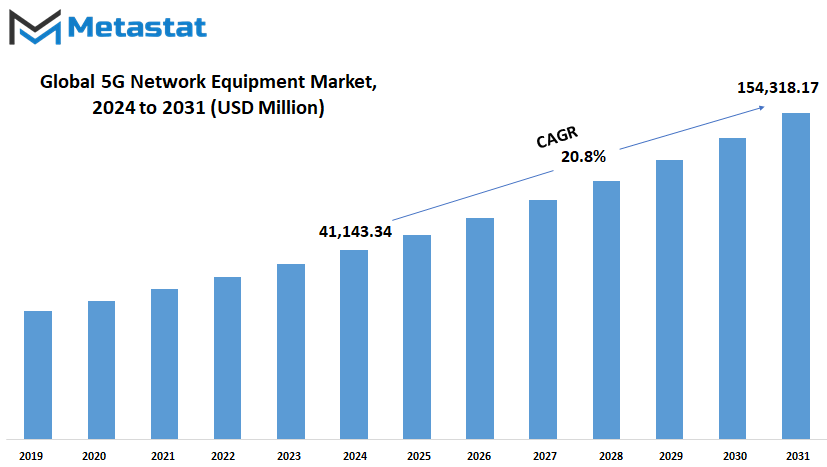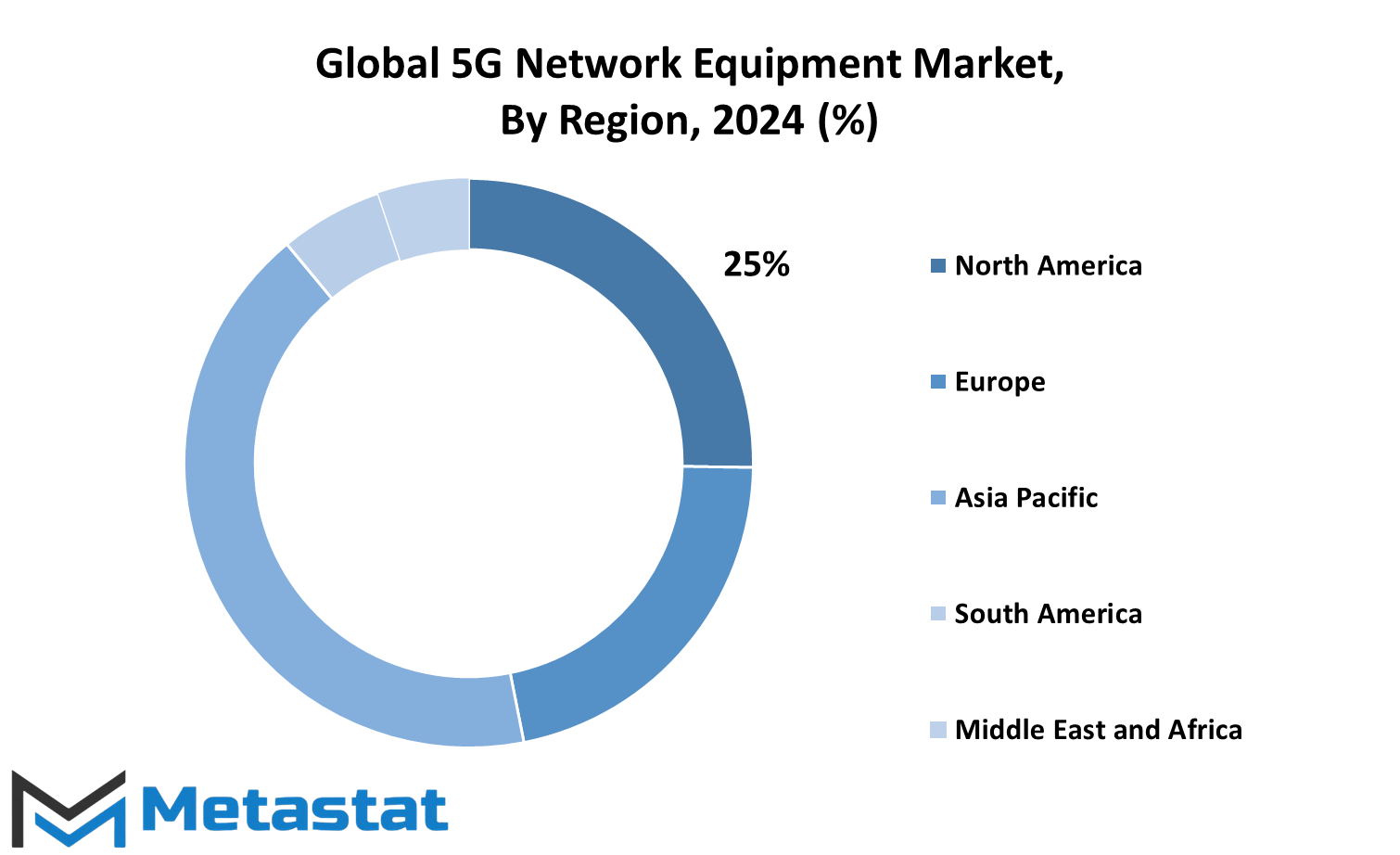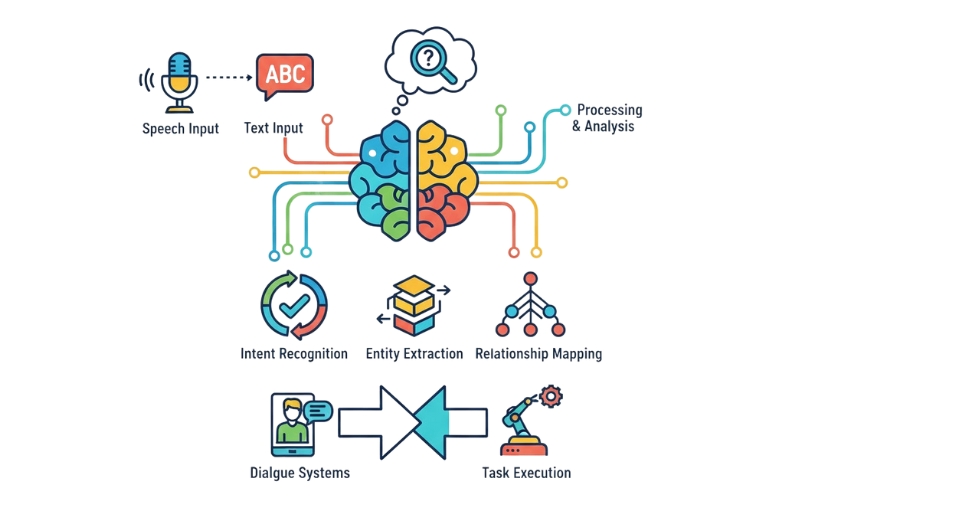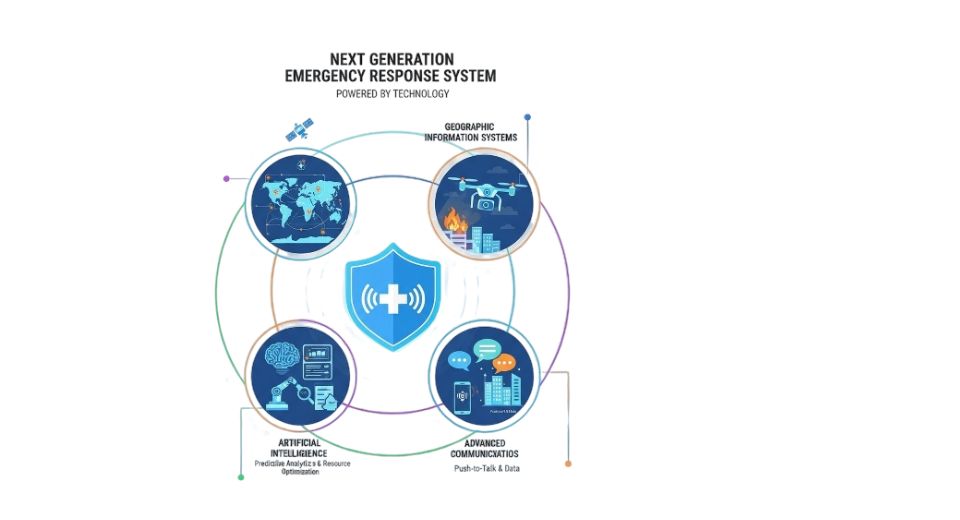MARKET OVERVIEW
The Global 5G Network Equipment market is one of the prime pillars of technological development, involving the fundamental infrastructures necessary to deploy fifth-generation wireless communication systems across the world. With growing demand for speedier connectivity, low latency, and higher data capacity, this industry will play a significant role in the digital future. Network equipment in 5G technology supports efficient communication across diverse sectors, ranging from consumer devices to industrial automation, facilitating smooth data transmission.
The market primarily focuses on giving advanced hardware and software solutions that would support the high-speed and reliable connectivity associated with 5G networks. That includes radio access networks, core networks, transport networks, as well as other infrastructure components of the network that are meant to make wireless communication a reality. These vendors in the Global 5G Network Equipment market will attempt to address concerns about data traffic, energy efficiency, and interoperability. These solutions will enable telecommunications providers to meet the growing consumer and enterprise demands for high-performance connectivity.
The Global 5G Network Equipment market will be spread across various geographies and applications. Telecommunications companies will be the main customers, depending on this equipment to roll out 5G services. However, the reach of the market will not be limited to traditional telecommunications alone. Its impact will further spread to connected devices, autonomous vehicles, remote health care services, and industrial automation systems. As the industries increase connected solutions, demand for 5G network equipment will increase, thereby leading to innovation in hardware and software capabilities.
Further, extensive collaboration between technology providers, equipment manufacturers, and network operators will be seen in the market. Such collaborations will focus on the development of solutions conformed to global standards, bringing better functionality and efficiency. Increased research and development activities would also witness since vendors would struggle to come up with advanced features such as enhanced network slicing, beamforming, and Massive MIMO (multiple-input, multiple-output) technology. These innovations would redefine the possibilities of wireless communication, and new applications and services would be developed on its basis.
Government policies and regulatory frameworks would drive the future course of this market through changes in investment plans and timelines. Regions will rapidly deploy the equipment, but it is a bit more complex for some as they experience infrastructure or regulatory difficulties. Despite the regional differences, the Global 5G Network Equipment market would play an important role in driving technology development.
Global 5G Network Equipment market is estimated to reach $154,318.17 Million by 2031; growing at a CAGR of 20.8% from 2024 to 2031.

GROWTH FACTORS
The global 5G network equipment market is likely to experience massive growth in the coming years with the rapid growth of communication technology. With more 5G networks spreading around the world, the demand for advanced equipment with faster speeds, low latency, and higher connectivity is expected to grow massively. The factors that would drive this market forward include increasing adoption of smart devices, rise in IoT applications, and a growing demand for reliable network solutions. Governments and private organizations are investing heavily into infrastructure development in order to have seamless implementation of 5G technology, thereby fueling demand for network equipment.
The increasing dependence on digital communication across industries, such as healthcare, manufacturing, and retail, is a significant growth driver. The new global shift that the pandemic brought about has made remote working practices a necessity, and thus there is a growing need for strong and fast networks. 5G technology promises to bridge the gaps in connectivity and enable revolutionary advancements in fields such as telemedicine, autonomous vehicles, and virtual reality. These will be built on the latest 5G network equipment that will sustain the demand.
Some challenges might hamper the growth of the market. The very high costs to develop and deploy 5G infrastructure are a barrier, especially for smaller businesses and emerging markets. Concerns about cybersecurity and data privacy have further raised questions over the safety of widespread adoption of 5G. These challenges must be addressed to allow the market to reach its full potential. Governments and industry leaders must work together to create policies and solutions that promote secure and affordable access to 5G technology.
The global 5G network equipment market is set to embark on a transformative journey with technological advancements and growing connectivity needs. Challenges will still be there, but innovation potential and reliance on digital solutions make this market a key focus for future growth. Strategic investments and collaborations will be crucial in shaping its trajectory over the coming years.
MARKET SEGMENTATION
By Product
The Global 5G Network Equipment market is an important building block in the progression of communication technology, shaping the way people and industries will interact in the future. This market is picking up steam because of its ability to support faster speeds, reduced latency, and increased capacity for more connected devices. By 2024, market valuation will capture the growing demand for and integration of 5G infrastructure through a wide product portfolio that captures the growing requirements of modern connectivity. Among such products, small cells are going to be the most valuable products with an estimate of USD 7,843.35 million.
These devices are essential to extend network coverage and ensure flawless connectivity in heavily populated areas. Another critical component is Active Antenna Units (AAU) which has a value of USD 10,728.77 million, incorporating the high frequency to effectively process the 5G communication aspect. Baseband Units (BBU), while very essential in processing network data, will be reaching USD 6,560.70 million, underlining the necessity for a solid foundation In constructing a 5G architecture. Valued at USD 2,463.80 million, this network’s backbone lays in the energy supply equipment, ensuring that 5G infrastructure works correctly, smooth and efficient. Macro cells, destined for USD 6,388.00 million, will continue to represent the core of long-range communication and high-capacity data transfer, crucial for the support of growing urban areas. Remote Radio Units, valued at approximately USD 4,439.29 million, will play an even greater role in optimizing wireless coverage and performance.
Additional parts are RF Filters and Phase Shifters, estimated at USD 1,560.21 million and USD 1,159.21 million respectively, that facilitate the fine-tuning of the signal quality and direction. Such smaller parts can make a big difference in making sure the network supplies the level of accuracy and speed required by newer applications.
Looking ahead, the Global 5G Network Equipment market holds much promise in terms of reshaping global connectivity. Widespread adoption is expected to accelerate further breakthroughs in healthcare, transportation, and manufacturing industries. With the integration of these technologies seamlessly, the smart cities, self-driving vehicles, and industrial automation are all on the cards for changing the face of the way the world communicates and works.
With an increasingly interconnected future, the growing value of each segment underscores the pivotal role the market will play in driving digital transformation. The combination of cutting-edge technologies and targeted investments ensures that the market will remain at the forefront of global progress.
By End Use
The global 5G network equipment market is going to take a transformational role in moulding communication and connectivity in the future. Given the increasing demands for faster Internet and more dependable connections, it will be something of a milestone in technological progression. With unmatched speed, decreased latency, and almost seamless connectivity, 5G technology may eventually redefine the interface with the digital world for business and governments as much as for private individuals.
According to its application, the market can be segmented into several sectors, such as commercial, industrial, government and defense, and residential. Each sector provides different opportunities for the deployment of 5G network equipment that, accordingly, contribute to the growth of the market in unique ways. The revolutionary change in industries such as retail, banking, and logistics will take place in the commercial sector due to the acceptance of 5G. With the faster transmission of data, and real-time communication, there will be smarter operations, improved customer experiences, and cost-effective solutions.
For instance, a retail business may incorporate augmented reality into their platforms, where a customer can see how a product looks inside their home before buying the item. The industrial sector will benefit immensely with the implementation of 5G. Advanced automation, combined with IoT, will result in more efficient production lines within manufacturing facilities. Sensors connected via 5G will be able to monitor the equipment in real-time, resulting in less time spent on standstill and reduction in operational cost. Such high connectivity would even make remote management and predictive maintenance possible.
5G technology will help the government and defense sectors enhance security and efficiency in operations. Military applications include unmanned vehicles and advanced surveillance systems. Governments can enhance public safety measures through enabling more effective communication between emergency services and bettering the reach of public services in rural and underserved areas.
Residential use of 5G equipment will also boom because consumers demand faster internet for streaming, gaming, and smart home devices. A more connected lifestyle can be fueled through adoption in homes, facilitating daily activities to be done efficiently and pleasantly.
Moving forward, Global 5G Network Equipment market would foresee a rising surge of innovations driven by a sense of greater urgency for all to go through a full-fledged process of digital transformation across all spheres. The expansion of this market would not only further enhance the systems that are in existence currently but also make way for new technologies which people have not yet envisioned, thereby keeping its relevance even in the coming years.
|
Forecast Period |
2024-2031 |
|
Market Size in 2024 |
$41,143.34 million |
|
Market Size by 2031 |
$154,318.17 Million |
|
Growth Rate from 2024 to 2031 |
20.8% |
|
Base Year |
2022 |
|
Regions Covered |
North America, Europe, Asia-Pacific Green, South America, Middle East & Africa |
REGIONAL ANALYSIS
The Global 5G Network Equipment market is one that is changing the face of connectivity, and its growth is supported by advancement in telecommunications as well as increased demand for high-speed internet. It is critical because it is a foundation for faster and more reliable communication networks that can support the likes of the Internet of Things, autonomous vehicles, and smart cities. A closer look at its regional distribution reveals unique dynamics that influence growth, making it imperative to understand the contribution of the different regions towards this transformative sector.
North America is a leading region in terms of 5G network equipment adoption in the United States, primarily due to its strong technological foundation and high investment from the major telecom companies. The remaining countries in the region, Canada and Mexico, are also on their way by initiatives through government for modernizing the telecommunications network in the country. This region has a great deal to contribute towards the growth of the market since it focuses more on innovation and is the early adopter of advanced technologies.
Europe is also not behind, with the UK, Germany, and France leading the charge for mass deployment of 5G. These countries focus on improving their industrial and consumer applications, from automation in manufacturing to smooth video streaming. Italy and the rest of Europe are embracing this technology, though at different speeds, depending on the regulatory policies and economic conditions. The region's commitment to digital transformation ensures its steady growth in the market.
Asia-Pacific was one of the most dynamic regions, with China and South Korea as leaders in the development of 5G. These countries had made incredible progress in deploying equipment for networks and had been using 5G for technological advancement. India and Japan were next, looking to further expand their digital infrastructure to fulfill the growing needs for faster connectivity. Rest of Asia-Pacific is diverse in its economic and technological maturity, yet it is slowly catching up because of regional collaborations and supportive policies.
As is seen, countries such as Brazil and Argentina stand above the rest today in terms of 5G solution implementation for South America on account of heightened demand to reduce the digital divide. Other economically unstable countries on the continent maintain plans to work towards improving reach, including internet connection.
Finally, there is a positive outlook in the Middle East & Africa region. The GCC nations are deeply investing in smart city initiatives. Egypt and South Africa are rolling out 5G in vast measures to strengthen their telecommunication infrastructure. There is increased engagement of 5G in transforming regional economies.

COMPETITIVE PLAYERS
The Global 5G Network Equipment market is advancing because of ever-growing demand for high-speed and reliable connectivity in the processes of various industries and regions. High-performance communication systems require a robust foundation that shall help the 5G network grow. This market spans innovative technologies brought about by different needs, including improved mobile broadband and application areas like health, transport, and manufacturing. The transition to 5G is not just an upgrade in speed but also the potential for transforming how businesses and individuals interact with technology.
Key players in the 5G Network Equipment market are taking proactive steps to remain competitive in this fast-paced sector. Some of the most innovative companies in this sector are Huawei Technologies Co., Ltd., Ericsson, and Nokia Corporation, who, with their skills, create equipment that would fit the demanding standards of 5G networks. Samsung Electronics Co., Ltd. and ZTE Corporation also are significant contributors in this sector by emphasizing scalability and performance in line with increasing demands from users. Notable players include Cisco Systems, Inc., NEC Corporation, Fujitsu Limited, and Qualcomm Technologies, Inc., each of which pushes the boundaries on designing solutions for seamless connectivity.
The competitive landscape is characterized by research and development efforts to face key challenges of deployment and adoption of 5G technology. For example, Intel Corporation and Juniper Networks, Inc., are working toward solutions that boost network efficiency while decreasing latency. CommScope Holding Company, Inc. and Corning Incorporated are contributing by developing components that improve signal transmission and infrastructure durability. Other smaller yet impactful firms Aviat Networks, Inc., Mavenir Systems, Inc., and Parallel Wireless are focusing on niche innovations, offering specialized solutions that cater to specific market segments.
More investments from countries on their 5G networks would further expand the global 5G Network Equipment market exponentially in the future. Because governments and private enterprises are now coming forward together to eliminate connectivity gaps, far-flung areas too can make use of high-speed internet. With this shift, more focus would be laid in supporting one's own piece of technology that has been introduced to people while stressing sustainability, energy efficiency, and cost-effectiveness. The market will only take advancement with more unparalleled opportunities for innovation and economic growth as 5G begins to roll out industries with help for automation, IoT adoption, and real-time data exchange. This dynamic environment underscores the importance of strategic investments and partnerships among industry leaders.
5G Network Equipment Market Key Segments:
By Product
- Small Cells
- AAU (Active Antenna Units)
- BBU (Baseband Units)
- Energy Supply Equipment
- Macro Cells
- RRU (Remote Radio Units)
- RF Filter
- Phase Shifters
By End Use
- Commercial
- Industrial
- Government & Defense
- Residential
Key Global 5G Network Equipment Industry Players
- Huawei Technologies Co., Ltd.
- Ericsson
- Nokia Corporation
- Samsung Electronics Co., Ltd.
- ZTE Corporation
- Cisco Systems, Inc.
- NEC Corporation
- Fujitsu Limited
- Qualcomm Technologies, Inc.
- Intel Corporation
- Juniper Networks, Inc.
- CommScope Holding Company, Inc.
- Corning Incorporated
- Aviat Networks, Inc.
- Mavenir Systems, Inc.
WHAT REPORT PROVIDES
- Full in-depth analysis of the parent Industry
- Important changes in market and its dynamics
- Segmentation details of the market
- Former, on-going, and projected market analysis in terms of volume and value
- Assessment of niche industry developments
- Market share analysis
- Key strategies of major players
- Emerging segments and regional growth potential








 US: +1 3023308252
US: +1 3023308252






